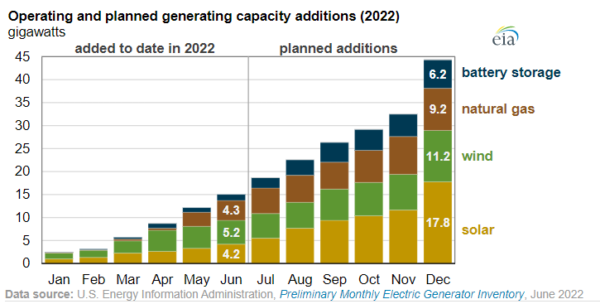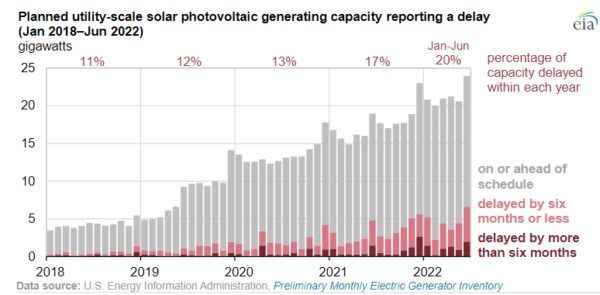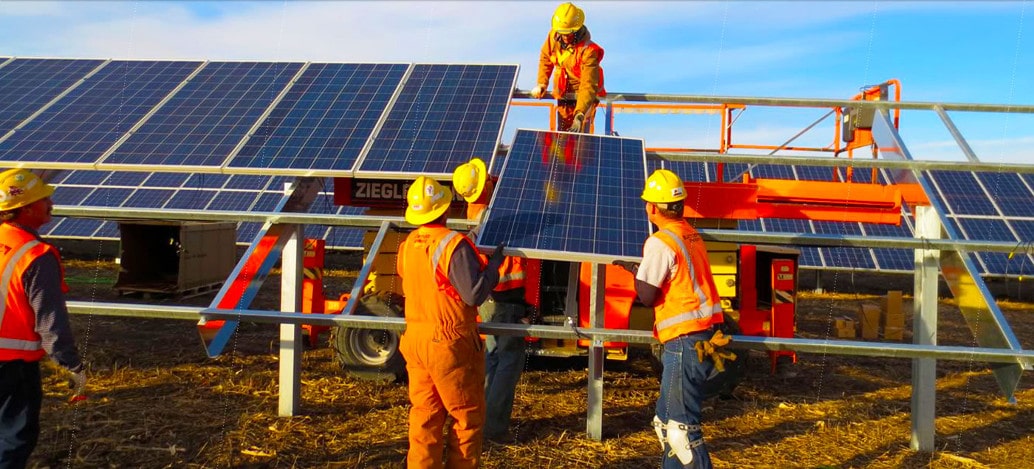The solar industry hit some obstacles in the first half of 2022, as deployment slowed due to module supply issues. The technology ranked third in the first six months of the year, installing 4.2 GW, trailing natural gas (4.3 GW) and wind (5.2 GW), according to the Energy Information Administration (EIA).
However, the United States is now on a path for record solar deployment, as the EIA expects the technology to reach 17.8 GW of additions to the grid by year’s end. These “high probability additions” would exceed year’s end totals for natural gas (9.2 GW) and wind (11.2 GW). Energy storage notably may achieve 6.2 GW of deployment by the end of 2022, said EIA.

Much of this less-than-desirable deployment level for the first half of 2022 can be attributed to module supply issues, which stem from a few different causes. One cause is the ongoing effect of the COVID-19 pandemic, which sent ripple effects through the global economy, including factory shutdowns, component shortages, and steeply increased shipping and materials costs.
Another significant impact was the Department of Commerce’s investigation of alleged antidumping violations by four Southeast Asian countries that are responsible for 80% of the U.S. supply of polysilicon solar modules. The threat of tariffs under the investigation could be as high as 50-250% of the cost of the modules, leading many developers to cancel or delay projects.
EIA said about 20% of utility-scale solar projects, sized 1 MW and up, were delayed in the first half of 2022. Reports show solar installations were delayed by an average of 4.4 GW each month, compared with average monthly delays of 2.6 GW during the same period last year.

EIA said it surveyed project developers and found most of the projects that will come online in the next 18 months are currently under construction. About 1.9 GW of solar capacity installations are projects currently under construction that have met delays but are still scheduled to come online in 2022; and another 1.7 GW under construction have been delayed to 2023.
Legislation to supercharge deployment
In June, President Biden took executive action to create a moratorium on solar tariffs related to the investigation, thereby clearing the uncertainty in the industry and advancing deployment in the nation. The administration also invoked the Defense Production Act to expand domestic production of solar goods. Any determination that Commerce makes on the anti-dumping investigation will apply after the 24-month moratorium, buying the industry time to deploy projects that were already planned. It was announced this month that any determination will not be made until November at the earliest.
These actions alone would have been a big boost to solar deployment, but U.S. lawmakers were not done yet. This month, the landmark legislation Inflation Reduction Act (IRA) of 2022 was passed, opening the floodgates for a decade of deployment.
The IRA is loaded with incentives that the solar industry has been requesting for years. Chief among them may be the long-term extension of the Investment Tax Credit at 30%. The 30% applies to both business and residential projects, including projects installed in 2022, and will last until the end of 2032.
For projects smaller than 5 MWac, interconnection costs will also be included in the tax credit. For projects of more than 1 MWac and above must pay attention to employment requirements. By default, the tax credit is 6%. To be eligible for the additional 24%, laborers and mechanics installing solar power projects must be paid prevailing wages and must be part of an electrical apprenticeship program. These tax credits will begin to apply to projects in 2023.
Solar power projects eligible for the full 30% tax credit can increase their tax credit by an additional 10%, up to 40% in total, by purchasing domestically produced hardware. Per the document, 100% of steel and iron must be manufactured in the United States. For manufactured goods – like solar panels, inverters, and electrical gear – the goods must initially be 40% U.S. manufactured, though this percentage will increase in the future.
Projects that are located in former ‘energy communities’ can earn an additional 10% tax credit. Energy communities are first defined as brownfields, and secondly as locations associated with fossil fuels over the last generation.
If a solar power project meets the prevailing wage requirements, it will receive a tax credit of 2.5 cents/kWh for the first ten years of a project’s life in the form of a production credit. If a project does not meet prevailing wage standards, it will earn only 0.3 cents/kWh before adjustment for inflation.
Additionally, there is a 10% adder for solar power projects that sell their electricity via community solar projects to low-income individuals. Added to all the other tax credit opportunities, the credit could reach as high as 60%.
The Act also includes heavy incentives for boosting U.S. manufacturing. While this won’t have a direct impact on the near-term wave of solar installations, it is an important step in securing a stable supply of solar components for the long term.
All told, reopening solar supply and heavily incentivizing the technology should dramatically boost something that was already in high demand. In a report made by a consortium led by Princeton University called the REPEAT project, it is estimated that solar deployment may accelerate from 2020 rates of 10 GW a year to 50 GW a year by 2024. By 2031, that number may reach as high as 100 GW per year, according to the REPEAT study.
This content is protected by copyright and may not be reused. If you want to cooperate with us and would like to reuse some of our content, please contact: editors@pv-magazine.com.









By submitting this form you agree to pv magazine using your data for the purposes of publishing your comment.
Your personal data will only be disclosed or otherwise transmitted to third parties for the purposes of spam filtering or if this is necessary for technical maintenance of the website. Any other transfer to third parties will not take place unless this is justified on the basis of applicable data protection regulations or if pv magazine is legally obliged to do so.
You may revoke this consent at any time with effect for the future, in which case your personal data will be deleted immediately. Otherwise, your data will be deleted if pv magazine has processed your request or the purpose of data storage is fulfilled.
Further information on data privacy can be found in our Data Protection Policy.